I am back again. Not quite firing on all cylinders yet but getting there. Back again from where, you may or may not wonder – Barcelona and the south of France. Alas, in Nice Covid finally tracked me down after I had managed to avoid it for a full four years. Fortunately, it has been a fairly mild case for which I give credit to my many vaccinations and boosters but I do not recommend flying long haul when still in recovery. It did rather set me back.
Fortunately, the unwanted Covid experience was towards the end of my trip so I managed to pack in plenty before being forced into isolation. I need to gather my thoughts on the larger topics but thought I would start with a minor diversion into graveyards. I have never taken a great deal of interest in graveyards generally, although I have written often enough about the pretty flower combinations in Te Henui Cemetery in New Plymouth.Te Henui has set a high standard for graveyards in general.

It was entirely by accident that daughter and I stumbled upon the space-saver approach of a cemetery in Barcelona. I don’t know how the logistics work of fitting several members and generations of the same family into one of these coffin-sized stacked compartments. Some of the stacks were seven stories high which must give some challenges when it comes to opening the entrance to add another deceased. Are they maybe just adding ashes in urns?
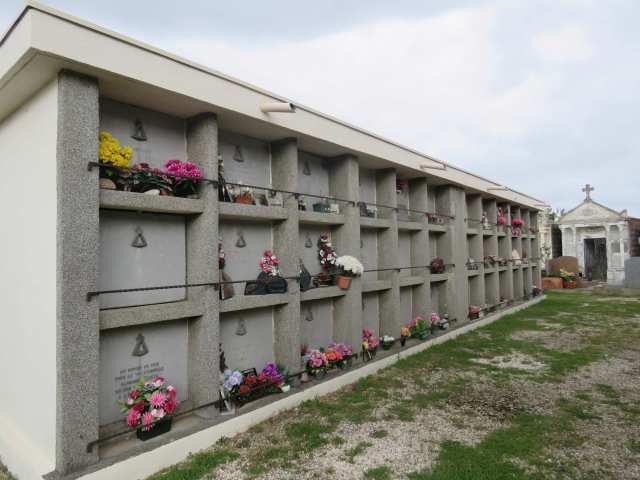
I found the modern version of the grave condominium in a small French graveyard in Montesquieu-des-Albères, the village closest to where my daughter is living for this year. These were three high, two deep and fully coffin-sized but clearly modern so not yet accommodating generations of the same family.
This burial technique may be utilitarian and lacking aesthetics but I can certainly see the practicality of it in terms of saving space while still enabling some sense of a permanent memorial. I had never really thought about the nature of graveyards before – that a one-off payment can secure a single plot that then becomes a permanent – sacred, even – installation where any maintenance becomes the responsibility of some other body to care for and respect the deceased down the decades and centuries. It is a curious concept, when you think about it. Over time, graveyards can take up a lot of space if they are predominantly one individual per plot.
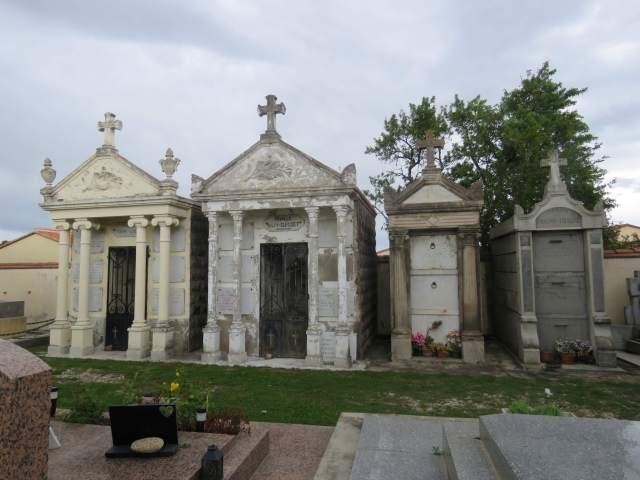
In death as in life, graveyard real estate can make differing social and economic status crystal clear. We have not generally gone for the family tombs in Aotearoa New Zealand. The French seem to be quite big on tombs and they do make a statement on the standing of la famille.

These graves, memorials and tombs in Montesquieu surround a church whose oldest parts date back to (wait for it) 1123.

I photographed the only pretty part of this cemetery. Overall, it could not hold a candle to our Te Henui one for plantings and beautification. Death can be a very austere experience.

When it comes to tombs and memorials, this one to the Hanbury Family in La Mortola, a botanical garden just across the Italian border from Nice, set a high standard for aesthetics and grace. I felt we might have sold Mark’s parents short. Both were cremated, in accordance with their wishes, and we brought their ashes back to the garden here that they created. It seemed entirely appropriate at the time. It is only when I saw this Hanbury memorial – which, if my memory serves me right, may house some of the family ashes – that gave me pause to ponder whether we should have done more. But I think it would have looked somewhat ostentatious and out of place in our garden.

I walked to the village cemetery at the end of the hilltop village of St Paul de Vence, drawn to see the grave of Marc Chagall who spent some time living there at the end of his life.
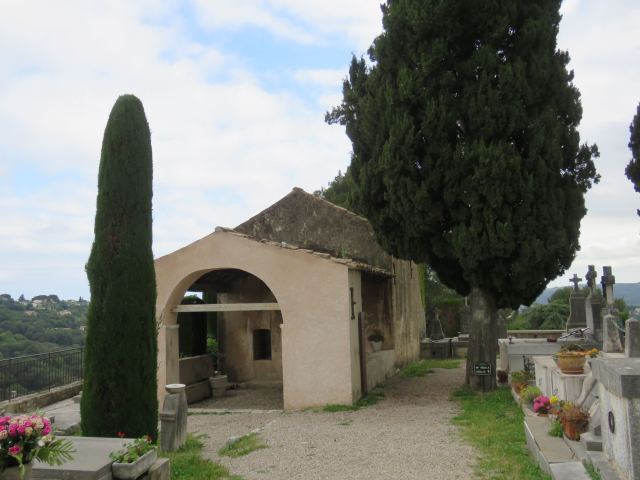
The graveyard chapel recorded that it was first mentioned back in 1356 so probably not quite as old as the church in Montesquieu.
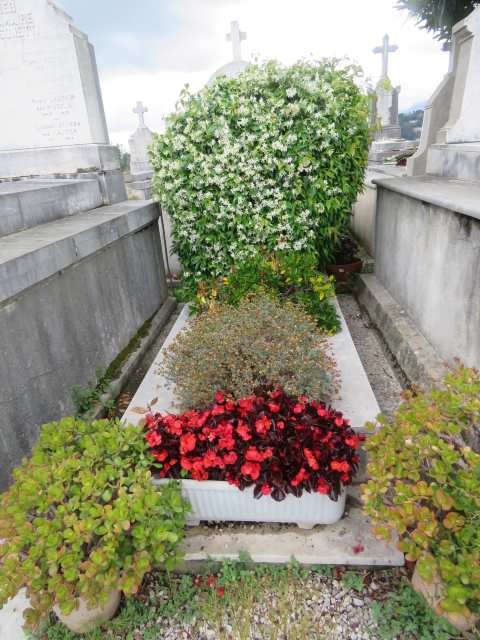
I did find one grave that was adorned with living, flowering plants but it was unusual. The families of St Paul de Vence favour the longevity of fake blooms.

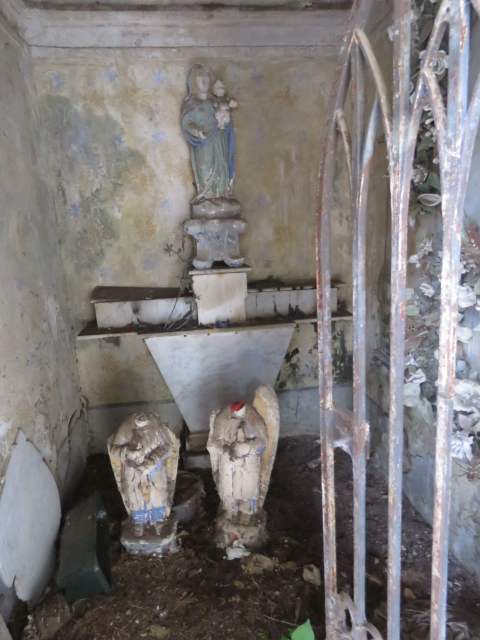

Back on tombs, I am not sure that there is much that is bleaker than a long disused family tomb. The Famille Lambert and Famille Flour appeared to have fallen into oblivion which was somewhat poignant to see.

The grave of Marc Chagall, however, has a casual but vibrant energy to it that belies his death in 1985. It also accommodates his second wife, Vava Chagall and a third person clearly attached to Vava because he bears her maiden name. If you look at Chagall’s lifetime of work, the grave seems all the more appropriate. It is clear that it is tended regularly to this day but I am not sure about the fake pink rose.
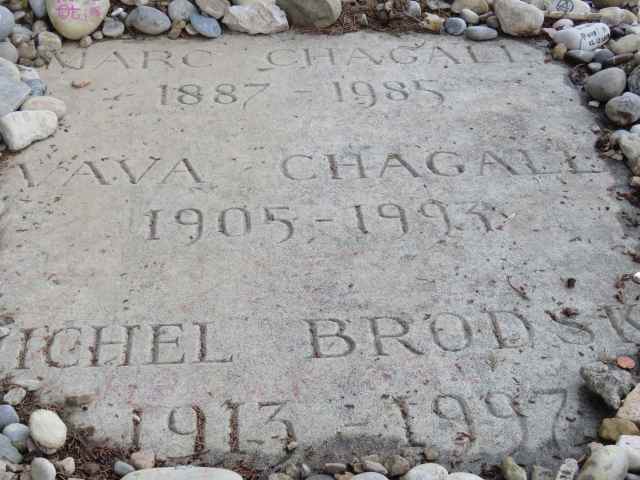

I think in England that after three generations, grave sites were reused. Any remaining bones disposed of unceremoniously. My last remaining uncle was a memorial stone mason in Dorset
Oh that is interesting. I did wonder if the grave site in perpetuity was a New Zealand custom.
My understanding is that graves are also perpetual in the US. Generally in France, there must be family to renew the plot rights. Otherwise, remains go into a common depository as space demands.
I was told that those who die in France without family, to be buried by the state only get three years before the space is reallocated. I guess it is more problematic when it is a fairly large concrete or stone tomb that was originally purchased by the family.
Thanks for the graveyard tour Abbie. Always interesting to me to see how other cultures deal with their dead. Me, I would quite like something in the Hanbury style, or maybe a pyramid. It’s the maintenance that is a little offputting. Settling back into nature seems fitting for Mark’s parents.
ps – nuisance that covid finally got you – seems common when travelling – difficult to avoid
The Hanbury one was indeed handsome. I feel a pyramid may be a case of cultural appropriation though. A construction from ponga logs may be more suitable in Aotearoa.
Oh dear, Covid, yes. I have continued to mask in crowded situations but when with a small group of 20 on a small coach and much dining in restaurants, I stoppped masking. And when one lovely lady sitting beside me apologised for her dry cough, I cheerfully replied, “No problem unless it is Covid.” She assured me it wasn’t but I now think it almost certainly was. They have generally stopped testing in Europe so I think I may have been the odd one out in that I was carrying a box of tests with me. I am now deeply distrustful of anybody and everybody with a dry cough, repeated sneezing and sniffing and snuffling and that covers quite a large number of people, really.
I hope you are well again. It must be annoying to travel from one end of the world to the other just to get Covid. After you had not posted for a while and the first post after that started with a picture of a cemetery I was actually afraid that something tragic had happened, fortunately not. I can truly relate to what you wrote. Since Covid I have never stopped wearing a mask when I am in a group of people, but I am always the only one. Unfortunately people have become very relaxed with it. By the way, Michel Brodsky was Vava’s brother, a famous photographer.
We will keep masking, André. It seems to have worked to keep us safe up until I stopped masking. Thank you for that information about Michel Brodsky. I had done a quick search but failed to find that information. Kind regards.